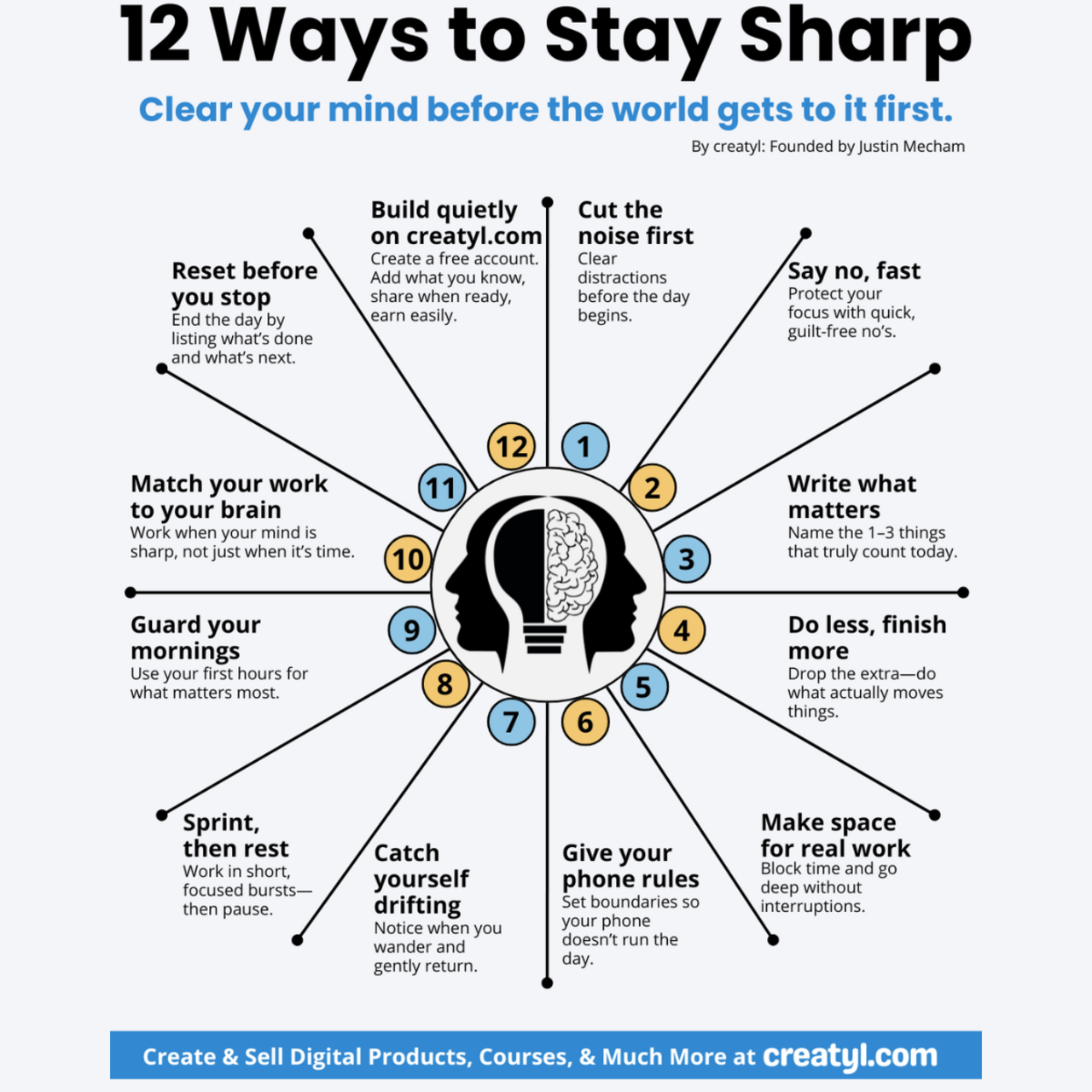Click Here To Download This Infographic
We talk a lot about working faster.
But what we don’t talk about enough is thinking slower.
Because the real danger isn’t indecision.
It’s unclear, rushed decision-making—especially when the pressure is high.
We’ve all been there:
You’re juggling back-to-back meetings.
A problem hits your inbox.
Someone wants your input.
And before you’ve had a moment to actually think, you’ve made a decision you’re not even sure you stand by.
This isn’t about overthinking or being indecisive.
This is about staying sharp enough to know when you’re not thinking clearly—and knowing how to reset when that happens.
Let’s break that down.
Why Sharp Thinking Doesn’t Come From More Thinking
A clear mind isn’t just about being smart.
It’s about knowing how your brain works when it’s overloaded—and stepping out of that loop before you make a call you’ll second-guess later.
Here’s what most people miss:
Mental fatigue doesn’t always feel like tiredness.
Sometimes it looks like short replies.
Sometimes it looks like decision regret.
Sometimes it’s just a vague sense of “Why did I agree to that?”
When your mind’s packed with noise, your decisions get rushed or reactive.
You fill in gaps, make assumptions, or move forward just to be done with it.
And that’s when mistakes happen—not because you’re careless, but because you were too full to be clear.
Real-Life: What Clarity Actually Looks Like on a Team
Let’s say there’s a cross-functional team working on a high-stakes product rollout—tech, marketing, and ops all involved.
On the surface, progress looks fine. Meetings run on time. Updates sound positive.
But behind the scenes?
Timelines are slipping.
Work is being duplicated.
Decisions are being made in silos.
And no one’s saying anything.
Why?
Because admitting you don’t know what’s going wrong can feel like admitting failure.
So instead, people stay quiet and keep pushing forward.
Until one person breaks the script.
In a review call, a department head says:
“We’ve been moving fast, but I don’t think we’re aligned. I’m missing something—are you seeing what I’m seeing?”
That small pause changes everything.
Marketing flags message confusion.
Ops brings up a resource gap.
Engineering shares backend issues that were buried.
It’s not a strategy overhaul.
It’s not a leadership shakeup.
It’s a moment of clarity that invites others to step out of the fog, too.
From that point on, alignment picks up.
Not because people worked harder—but because they stopped pretending they were fine.
How to Reset When Your Mind Feels Full
Here’s how to build the kind of sharp thinking that leads to better calls—especially when your plate is full and the pressure is high:
1. Notice when you’re cluttered.
Pause and ask yourself: “Am I reacting or deciding?”
That one question separates automatic habits from clear judgment.
2. Step away from urgency.
Even five minutes matters. A walk. A notebook. A closed laptop lid. Anything that tells your brain, “We don’t need to solve this yet.”
3. Use your body to shift your brain.
Stretch. Breathe. Stand up. Get cold water. Simple physical moves signal your system to reset.
4. Delay the decision—on purpose.
If it’s not urgent, make space to think. Sleep on it. Check it with a peer. Or ask, “What do I still need to know?”
5. Ask better questions.
Instead of “What should I do?”, ask:
“What problem am I really solving?”
“What’s the risk of doing this now vs. later?”
“What’s driving my rush—the deadline or the discomfort?”
You don’t need an empty calendar to think clearly.
You just need room to notice when you’re too full—and enough margin to make the reset.
Resources That Help You Stay Clear (and Actually Think Better)
Here are three tools we recommend when you need to slow down, cut through the noise, and stay sharp:
Tool: Clearer Thinking – Decision Advisor
This free, science-backed tool walks you through big choices by helping you weigh options, challenge assumptions, and calculate what really matters. It turns scattered thoughts into structured thinking—and keeps your head from spinning.
Book: Thinking, Fast and Slow by Daniel Kahneman
A bestselling breakdown of how your brain makes decisions. Kahneman explains how fast, reactive thinking often takes over—and how to pause, notice bias, and choose deliberately instead.
Podcast: Before You Decide: 3 Steps To Better Decision Making by Matthew Confer (TEDx)
A quick, practical episode with a framework used by leaders in high-pressure roles. Confer’s 3-step model helps you take a beat, clarify your goal, and lead with precision—even when you’re short on time.
The Real Skill Is Knowing When to Clear the Deck
The sharpest people in the room aren’t always the fastest thinkers.
They’re the ones who know when their mind’s too full to think straight—and who do something about it.
If your decisions feel rushed, if your thoughts feel jumbled, if your days are moving faster than your clarity can catch up—step back.
Ask yourself:
Have I made space to think?
Am I solving the real problem—or just trying to get through the noise?
What would this look like if I gave it room to breathe?
You don’t need more time. You need more clarity.
And that starts with giving yourself the space to notice when you’ve lost it.
That’s the work. And it’s what sets sharp thinking apart from just fast reacting.
Want the Infographic Version?
If you want to keep this breakdown close—print it, save it, or share it with someone who needs it—
we’ve turned the full framework into a simple, powerful one-page PDF.
Everything you just read—distilled into one quick-glance guide.
No fluff. No filler. Just clear moves tied to real feelings you’ve probably had before.
Save it. Share it. Use it when you feel stuck.
Because sometimes, it just takes one reminder to get you to think slower..





